States > Odisha
Top Destinations in Odisha
• Puri
Must See Palaces in India
The most awe-inspiring part of the palaces is that of melancholy, for an era gone by never to return. India is, maybe, the only country in the world to house palaces of almost every gone by era, from the Old Stone Age to the Colonial Rule and it is also might amaze you to know that some palaces still serve as homes to the former rulers, elevating them from sheer magnum opus of architecture to something more valuable - living examples of the past and present coming together.
So, get acquainted with these citadels - antique relics and the taciturn onlookers of the Indian glory.
Lake Palace:
One of the most beautiful palaces in the world, The Lake Palace of Udaipur, is the finest example of Oriental workmanship. Situated on a natural foundation of four acres rock on the Jag Niwas Island in Pichola Lake, it was built by the Sisodias in the 17th Century and is exemplified by splendor and grandeur - the hallmark of the Rajputs in the medieval ages. The palace consists of royal durbars, vast courtyards, pillared terraces, fountains and gardens, which all add unique fascination to this grand palace. The presence of mirrors, engravings, inlaid stones of pink, green lotus leaves pointed arches and dramatic motifs add to the fascination. The palace also houses various other beautiful buildings like are Bada Mahal, Ajjan Niwas, Phool Mahal and Kush Mahal.
This stunning palace has now been transformed into a luxury heritage hotel run by the Taj Hotels Resorts and Palaces and is called Hotel Taj Lake Palace.
Hawa Mahal:
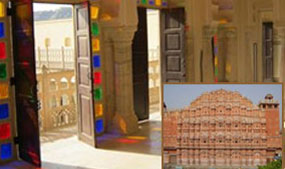
Also known as "The Place of Winds" or "the Palace of Breeze", Hawa Mahal is one of the main attractions of Jaipur. Built in the year 1799 by Raja Sawai Pratap Singh, the palace served as the windows of royal ladies to observe daily activities or viewing processions without being seen. The palace's unique five-storey exterior is akin to the honeycomb of a beehive and is also designed by Lal Chand Usta in the form of the crown of Lord Krishna. The portico of the palace has semi-octagonal suspended windows with perforated screens, curved and wavy roofs, domes and finials. The most interesting part is that as compared to the elaborate exteriors, the inside of the palace is very simple.
Umaid Bhawan:
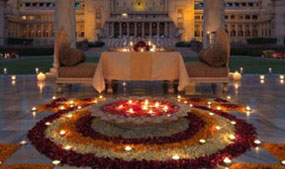
One of the most magnificent and popular palace complexes in the country, the Umaid Bhawan in Jodhpur, Rajasthan, is built entirely using sandstone. The palace was built by Maharaja Umaid Singh and was the last expression of princely architectural burlesque during the British Raj. The palace was converted into a hotel in 1977 and divided into three sections- a royal apartment where the royal family resides, a hotel run by the Taj Group and a Museum that showcases a rich display of royal artifacts belonging to the royal family. The clock collection on display is a must and should not be missed.
Bangalore Palace:
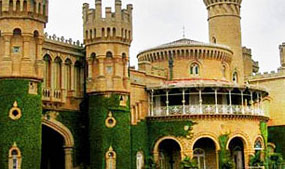
Built to look like a smaller replica of the Windsor Castle in England, the Bangalore Palace was built by Rev. Garrett, he Principal of the Central High School in Bangalore which is now known as the Central College. The construction of the Palace started in 1862 and completed in 1944. The Maharaja of Mysore - Chamraja Wodeyar- bought the palace in 1884 and it is now owned by the current scion of the Mysore royal family, Srikanta Datta Narasinmharaja Wodeyar. It is decked with outstanding woodcarvings and Tudor-style architecture on the inside. Fortified towers, Gothic windows, battlements and turrets lend a great degree of glory to the Bangalore Palace of India. Largely built of wood, it brags of fine carvings and paintings. Today the palace serves as the venue for various exhibitions, concerts and cultural programs held in the city.
Mysore Palace:
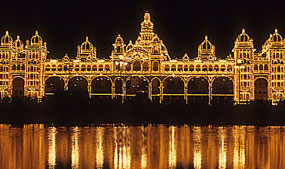
The official residence of the Wodeyars, the erstwhile royal family of Mysore - The Mysore Palace - is situated IN THE City of Palaces Mysore. The Wodeyar kings first built a palace in Mysore in the 14th century; it was demolished and constructed multiple times. The current palace construction was commissioned in 1897, and it was completed in 1912 and expanded later around 1940. The architectural style of the palace is commonly described as Indo-Saracenic, and blends together Hindu, Muslim, Rajput, and Gothic styles of architecture. Mysore palace is now one of the most famous tourist attractions in India after Taj Mahal with more than 2.7 million visitors. The palace consists of three unique rooms- Ambavilasa, Gombe Thotti (Doll's Pavilion) and Kalyana Mantapa.
Thirumalai Nayak Palace:
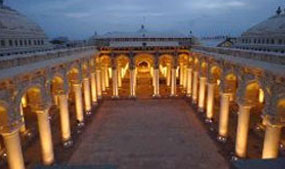
A 11th century palace built in 1636 AD by Thirumalai Nayak, a king of Madurai's Nayaka Dynasty who ruled Madurai from 1623-59. The design and architecture is a blend of Dravidian, Islamic and European styles of architecture. The building seen today was the main palace where the king lived. The original Palace Complex was four times bigger than the present structure. In its glory days, the palace was considered to be one of the wonders of the South.
Orchha Palaces:
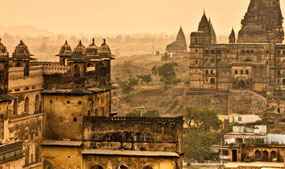
A combination of palaces on the seasonal island on the bank of Betwa River stands a huge palace fort. The fort consists of several connected buildings, the most noteworthy of which are the Raja Mahal and Jahangir Mahal. Situated in the Orchha District of Madhya Pradesh, its construction took place by the King of Orccha, Raja Rudra Pratap but he died in 1531 leaving the work of construction half-way. His son then continued with the construction. The final touches were given by later on Kings. The Jahangir Mahal was constructed in the honor of Mughal Emperor Jahangir by Orccha Emperor, Vir Singh for the emperor's one day stay!
Fatehpur Sikri:
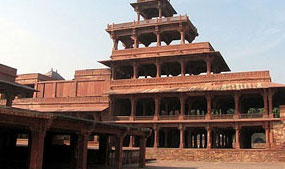
A palace complex built by the Mughal Emperor, Jalal'ud-Din Muhammad Akbar, the palace complex of Fatehpur Sikri is situated on a ridge of a hill about 40 meters in height by the side of an artificial lake. The palace shows a fusion of various schools of architecture craftsmanship such as Gujarat and Bengal as native craftsmen from various regions were used for the construction of the buildings. Influences from Hindu and Jain architecture are seen converging with Islamic elements. The material used in all the buildings at Fatehpur Sikri, is the locally dug out red sandstone, known as 'Sikri sandstone'. The palace can be accessed through gates along the five-mile long fort wall, namely, Delhi Gate, the Lal Gate, the Agra Gate, Birbal's Gate, Chandanpal Gate, The Gwalior Gate, the Tehra Gate, the Chor Gate and the Ajmere Gate.
Ujjayanta Palace:
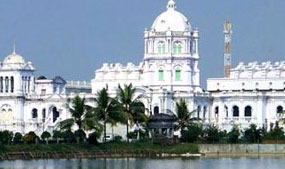
Tripura's indisputable leading site and centerpiece is the Ujjayanta palace. This royal residence of the Manikya kings is a striking, dome-shaped palace built in 1901. It also features massive Mughal style gardens, lofty ceilings, and artistic doors of curved wood. It is also flanked by two reflecting ponds and looks impressive floodlit at night. It offers a feast to the stroller's eyes for just one hour daily.
Vijay Vilas Palace:
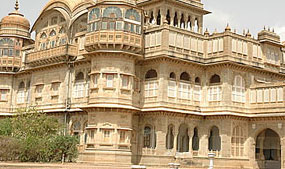
The Vijay Vilas Palace ascends from a multi-acre estate along the coast of Kachchh district in Gujrat. This palace of His Highness Maharao Vijay Singhji, who ruled over Kutch in the 1940s, is an assorted combination of architectural styles. Umbrella-domes like those seen in palaces of Bengal, cupolas found in Mughal buildings, jarokhas and cusp-arches like those seen in Rajput palaces of Rajasthan, Victorian Gothic arches and classical columns make up the ensemble. However the architects were skilled enough to make the entire complex look harmonious.